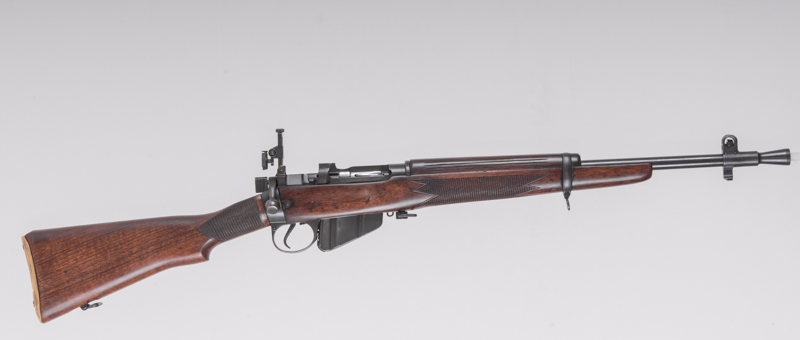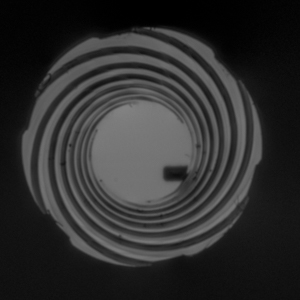A Lee-Enfield .22RF No.5 Rifle
with Rifle No.7 type action
Please be aware that some specialist imagery may take time to load.
This site is designed for dedicated researchers, and is best viewed on desktop.
See also: ......Lee-Enfield Rifle No.7 ...... - ......Lee-Enfield Training Rifles
A most unusual "Jungle Carbine" style cadet training/target rifle with the 5-round magazine-fed action
superseding that of the .22RF No.5 rifle and its associated .22RF No.6 rifle

This model is not marked with any manufacturer's specific name or code,
although both the No.5 rifle action and some components carry a "B" stamp.
This may suggest manufacture by the Birmingham Small Arms Company,
but whose usual code of "M47C" is not to be found.
The rifle was purchased at auction in 2005 with iron-work in rather poor condition,
and has since been carefully and sympathetically refurbished.
The next two images can be rotated and zoomed, either as initially loaded or full-screen for higher definition.
DATA TABLE - ALL MEASUREMENTS AS VIEWED EXAMPLE |
||
FIREARM |
IMPERIAL |
(METRIC) |
| Designation or Type : | Military Style Training Rifle
|
|
| Manufacturer : | Possibly Birmingham Small Arms Co. |
|
| Date : | ca 1948 |
|
| Serial No : | "BS0198" on butt-socket LHS, bolt-handle and magazine base |
|
| Furniture : | Walnut
|
|
| Action Type : | Turning bolt
|
|
| Nomenclature or main marks: | "1" on butt-socket RHS
|
|
| Calibre : | .22RF |
- |
| Weight : | 8 lbs. 2½ ozs. |
3.70 kgs |
| Length - Overall : | 35½ inches |
90.2 cms |
| Length - Barrel : | 18½ inches |
47 cms |
| Pull : | 13½ inches |
34 cms |
| Spare row : | - |
|
Rifling - No. of Grooves : |
6 |
tight bore slugged at 0.221" |
| Rifling - Twist & Direction : | 1 turn in 16 inches - RH |
1 : 40.7 cms |
| Rifling - Groove width : | 0.090 inches |
0.8 mm |
| Rifling - Land width : | 0.032 inches |
2.29 mm |
Rifling - Groove depth at muzzle : |
0.005 inches |
0.13 mm |
| Sight - Fore : | Standard blade between No.5 side protectors
|
|
| Sight - Rear : | Parker-Hale No.4 tangent leaf with windage and 6-hole aperture
|
|
| Sight - Radius : | 23 inches |
58.4 cms |
Below are the disassembled major components
Click image to bring up hi-res file and magnifier
Next, left, a view of the rear of the action with bolt open and sight raised.
Right, bolt closed and sight folded down.
The rear-sight leaf has two scribed lines on its right hand side, presumably for 25 and 50 yard range settings.
 .......................
.......................
Below, the ejector side plate is evident low down on the flat side of the receiver.
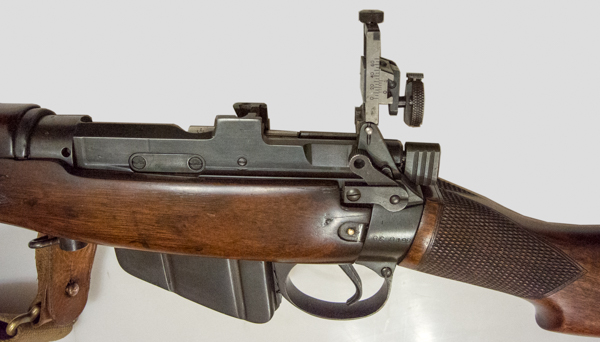
The furniture has a plain rounded wood fore-end nose, rather than the steel nose-capping later seen.

A standard No.5 rifle foresight and flash-hider

The No.7 (British R.A.F. type) rifle bolt locking lug is stamped with the number "1"
and the British Nitro Proof (BNP) mark
with the military acceptance mark of crossed pennants.
The No.7 magazine insert can be seen fitted into the modified No.4 magazine shell.

Next, the modified No.4 rifle magazine shell with the platform slotted for the .22 magazine insert,
plus the insert converted by BSA from their own Sportsman Five rifle magazine by the
simple expedient of inverting the latching arrangement, which was
originally intended for the fitment of the magazine from underneath.
There was also a minor alteration to the profile of the side-plates of the unit.
Further detail can be found included with the page on the BSA Lee-Enfield No.7 rifle
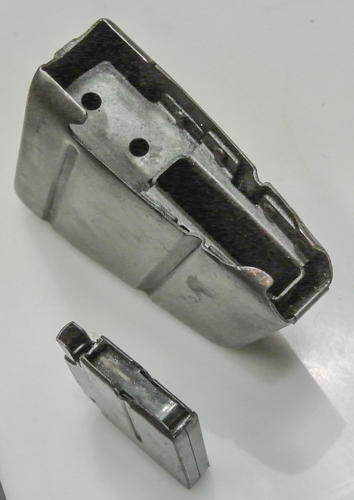
The disassembled bolt, showing the firing-pin and return spring on its location rod,
The secondary extractor is shown in its groove with its small countersunk fixing screw.
The main extractor is out of view on the opposite side of the bolt-head....

... as can be seen in the next image, which also shows the recessed face
to accommodate the .22 long-rifle cartridge rim.

The underside of the finely chequered butt-stock wrist carries the makers code and Broad Arrow stamp

The trigger-guard unit is marked with the "B" of the Birmingham Small Arms Company.
The bedding-screw of the sling-swivel carries both a Broad Arrow and the "D" with a central bar
that is the clever combination of the often seen "EFD" mark of the Royal Small Arms Factory (R.S.A.F.) at Enfield.

The Parker-Hale manufactured PH4 target rear-sight
replaced either the standard No.4 or No.5 sight leaves,
adding the benefit of vernier calibrated elevation on the left of the leaf,
in addition to the usual 200-1,100 yard settings on the rear face.
The greatest advantage of the PH4 sight, that was introduced at Bisley in 1946,
was the windage adjustment with its own vernier scale, along with the ability
to add orthoptic aperture eyepieces, either single or multiple, to both suit the shooter and conditions.
More details of this sight are to be found onsite here.
 ..............................................
..............................................
The bore is shown below from the muzzle. It is in fine condition.
The dark rectangle low on the right is the ejector blade
projecting into the magazine-well from the LHS of the receiver.
CLICKING ON THE RIFLING IMAGE BELOW WILL SHOW A SHORT VIDEO CLIP
OF A PASSAGE THROUGH THE BORE FROM THE BREECH
Below are images of the lead slug - in the form of a plain swaged .22 bullet - that has been passed through this barrel.
In the right-hand image, the very slightly slanted indentation from land is in the centre,
and the compression of the bullet in the grooves can be seen either side.
See the Measurements Table above for dimensions
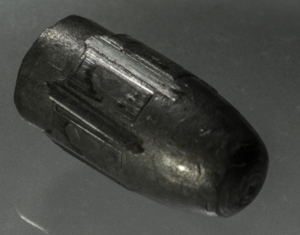 ...............................................
...............................................
Plain .22 bullet used as a slug from which measurements are taken .......................................... A microscopic image of groove in slug made by rifling land
See also: the BSA .22 No.5 trials rifle or the the BSA .22 No.6 trials rifle
Return to: TOP of PAGE
See this website's Raison d'être
